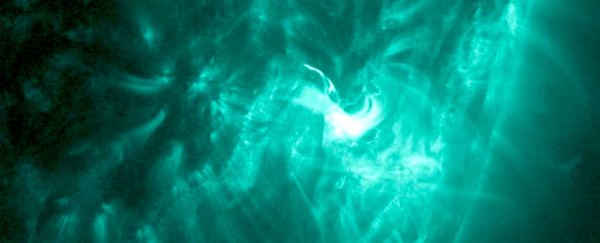Researchers have finally observed something that scientists had speculated about for years but never had a chance to witness: the Sun shredding apart its own, failed solar eruption.
The Sun produces intense solar flares when a build-up of magnetic energy is suddenly released from the solar surface – but as scientists can now show, the same invisible and mysterious forces can also terminate these epic outbursts.
To catch this failed eruption as it happened took coordinated measurements from numerous NASA instruments including the space agency's Solar Dynamics Observatory (SDO) and the VAULT2.0 rocket.
VAULT2.0 is a sounding rocket – a sub-orbital rocket that flies for around 20 minutes above Earth's atmosphere to collect readings, before returning to Earth.
 NASA's Goddard Space Flight Centre
NASA's Goddard Space Flight Centre
In this case, VAULT2.0 was focussed on an area of intense, complex magnetic activity on the Sun, which the team anticipated might produce a coronal mass ejection – a violent eruption of solar material and magnetic fields.
But, on this day at least, the Sun had other ideas.
While the team observed a filament of dense solar material start to rise from the solar surface, it ultimately collapsed, instead of being ejected from the Sun – the first time this phenomenon has been recorded.
"We were expecting an eruption; this was the most active region on the Sun that day," says astrophysicist Angelos Vourlidas from Johns Hopkins University.
"We saw the filament lifting with IRIS [NASA's Interface Region Imaging Spectrograph], but we didn't see it erupt in SDO or in the coronagraphs. That's how we knew it failed."
To figure out what prevented the filament from shooting out into space, Vourlidas and fellow researchers came up with a model that sought to explain how regions in the Sun's magnetic field could become compressed or distorted.
When solar structures with opposite magnetic orientations run into one another, the collision typically produces flares and coronal mass ejections, due to the release of magnetic energy.
But the team says other results are also possible too, depending on what kind of magnetic orientations are at play.
"We computed the Sun's magnetic environment by tracing millions of magnetic field lines and looking at how neighbouring field lines connect and diverge," says astrophysicist Antonia Savcheva from Harvard University.
"The amount of divergence gives us a measure of the topology."
The team's model suggests that the right kind of magnetic structure could have in fact acted as an invisible boundary to contain the filament.
This boundary, which is called a hyperbolic flux tube, could be formed by a collision of two bipolar regions on the Sun's surface, and would be shaped like two igloos smashed against each other.
The team says this structure would effectively chip away at the filament like a log grinder, shredding the snake-like form of solar material and dispersing its heat and energy back into the solar atmosphere.
"The hyperbolic flux tube breaks the filament's magnetic field lines and reconnects them with those of the ambient Sun," explains solar physicist Georgios Chintzoglou from the Lockheed Martin Solar and Astrophysics Laboratory in Palo Alto, "so that the filament's magnetic energy is stripped away."
Or, in other words, the final score is: hyperbolic flux tube 1, filament 0.
It's only a hypothesis for now, but the researchers say it helps explain what could be happening in this unprecedented dataset – and that's important stuff to know.
All too often we're made aware of how potentially threatening intense solar storms could be to us on Earth – but this research shows that while the Sun's internal forces could come together to unleash the Dark Ages upon us, the same mysterious forces can also work to keep that violence at bay.
"Most research has gone into how topology helps eruptions escape," Chintzoglou says.
"But this tells us that apart from the eruption mechanism, we also need to consider what the nascent structure encounters in the beginning, and how it might be stopped."
The Sun has our back, people – or at least it does sometimes.
The flare occurred in September 2014, with the final findings reported in July 2017's The Astrophysical Journal.
